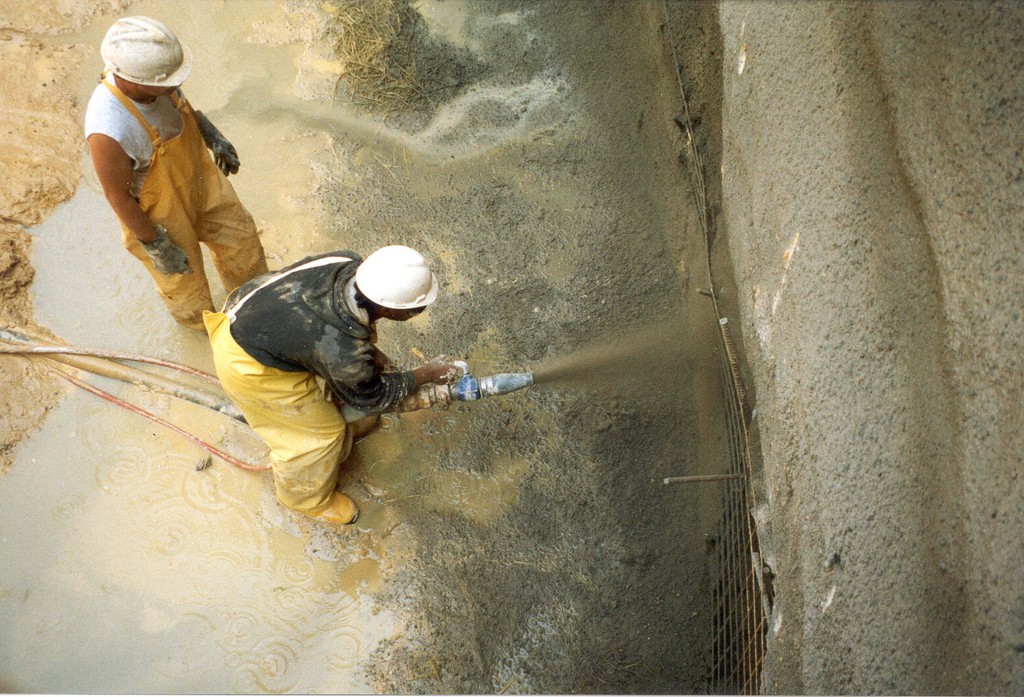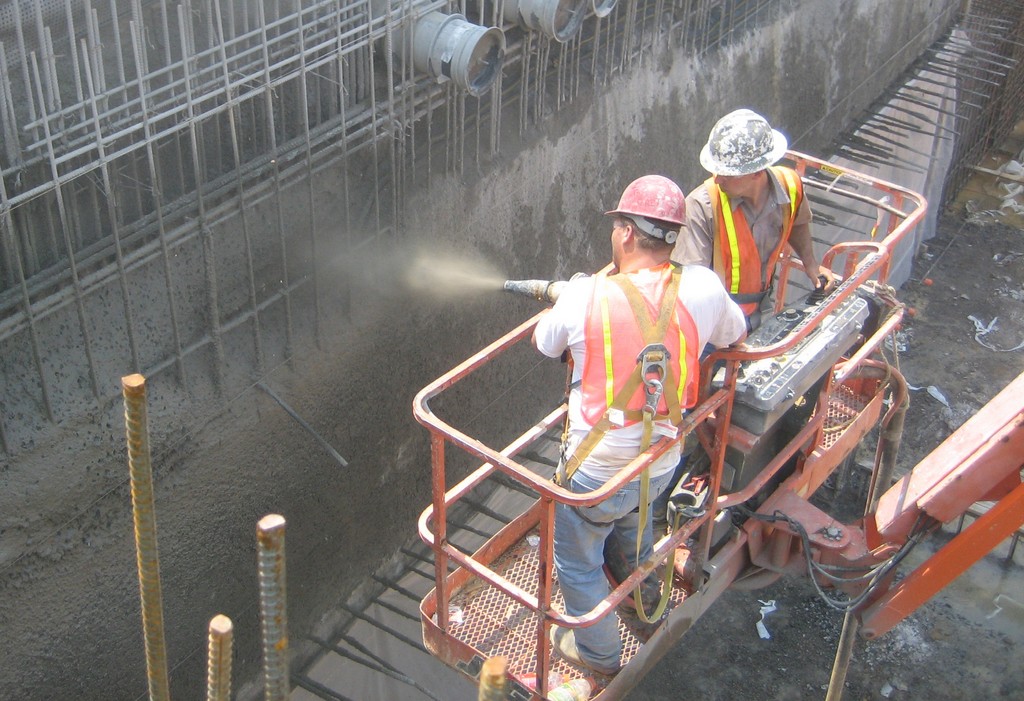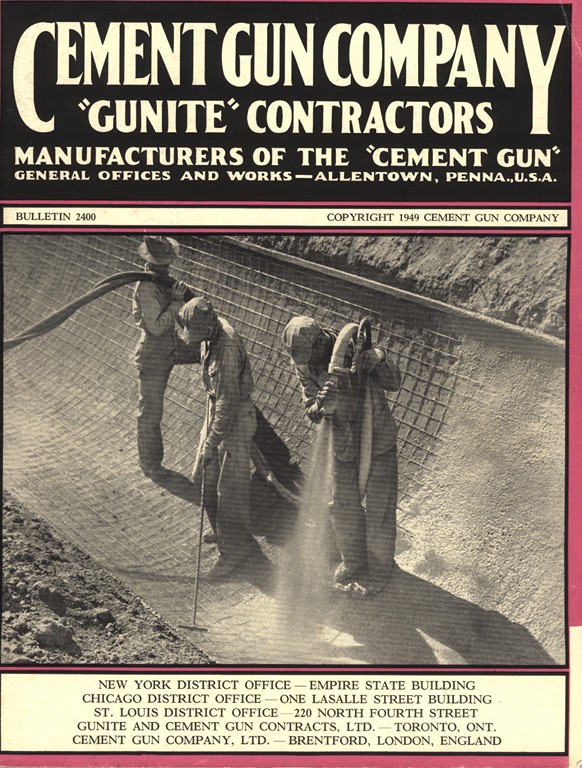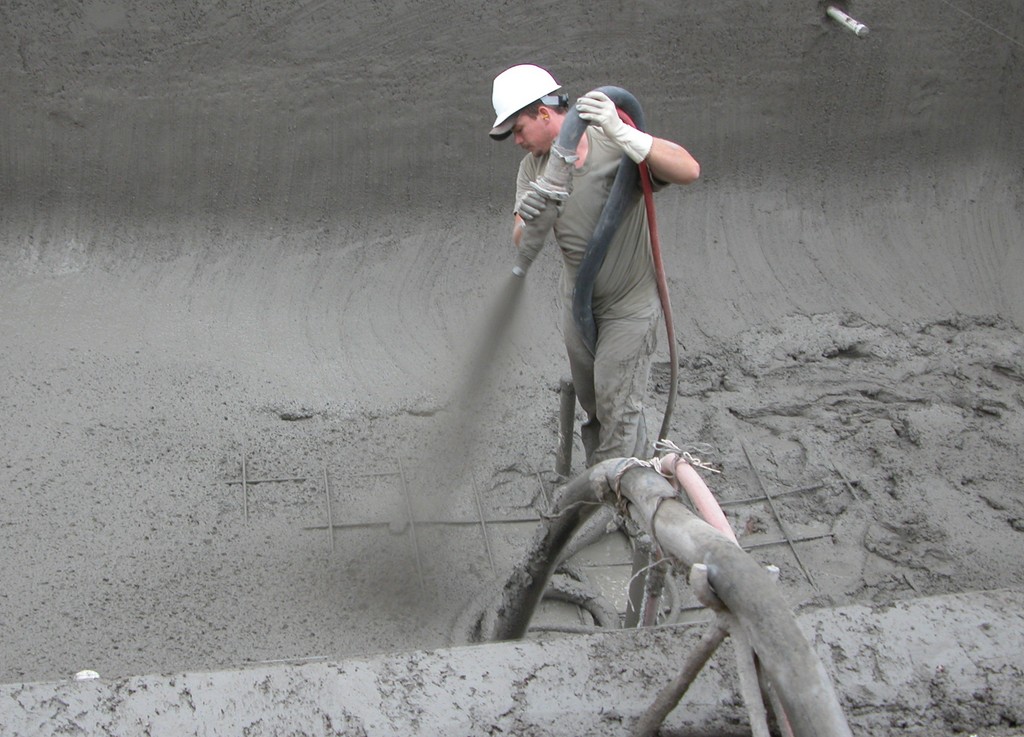The Elevated Game

In the world of concrete science and application, innumerable variables have an influence on whether a concrete installation is successful or not. These include but are not limited to the skill of the applicator, the suitability of the mix design, the temperature at the time of application, the equipment used, the water-to-cement ratio and the size of the aggregate.
For all the seeming complexity, however, the nature of the material itself invests the process with a few immovable facts. One of these directly undermines the swimming pool industry’s “standard” that calls for a compression strength of 2,500 pounds per square inch for pneumatically placed concrete (that is, gunite or shotcrete). It’s not because the standard is inadequate per se; rather, it’s because it is virtually impossible, with proper application, to produce a gunite or shotcrete structure at such a low level!
If that comes as a surprise to you, read on: To explain why no such thing as 2,500-psi pneumatically placed concrete exists, we first need to examine the nature of concrete and then take a look at the developmental history of the gunite and shotcrete processes.
THROUGH THE PUMP
The main reason behind the impossibility of 2,500 psi gunite or shotcrete has to do with the velocity at which the material is applied. As it moves past the nozzle, the concrete strikes the substrate with such force that it is inevitably compacted – meaning it will always have greater strength than you can achieve using cast-in-place methods.
So regardless of the mix design, the resulting structure’s density (or compressive strength) will be at least 4,000 psi in the shotcrete (wet) process and even greater with the gunite (dry) process. Without significant errors in application (to be discussed below), you simply cannot avoid producing shells with compressive strength far exceeding 2,500 psi – which means the industry standard is essentially meaningless.
Moving past that observation, let’s look at some other concrete fundamentals.
First of all, it’s helpful to know that the terms “gunite” and “shotcrete” are essentially verbs, not nouns, and refer to processes and actions rather than to results. The stuff that constitutes the shell of a swimming pool or spa or fountain, in other words, is not gunite or shotcrete but is, in fact, simply concrete – concrete placed pneumatically at high velocity, to be more exact.
The nature of these application methods has a direct effect on the mix design of the concrete. If you’re pouring a footing for a home or a column for a building, for example, standard practice dictates use of a fairly coarse aggregate in inch or inch-and-a-half dimensions. With the gunite or shotcrete method, by contrast, the material has to move through a hose and nozzle, which means you must downsize the aggregate considerably and increase the amount of sand in the mix to make it flow properly.
By definition, concrete is a combination of coarse and fine aggregates coated and bound together by cement paste. By decreasing the size of the aggregate, you effectively increase the surface area of the aggregate and thereby increase the requisite amount of cement. In other words, the amount of cement required in the mix is determined by aggregate size and the aggregate’s resulting surface area.
For comparison, if you were preparing for a cast-in-place application using inch to inch-and-a-half aggregate, the production of a cubic yard of concrete would require inclusion of 500 to 550 pounds of cement. If you were to downsize the aggregate to three-eighths of an inch (as is generally found in gunite and shotcrete applications), that same cubic yard of concrete would have to include 650 to 750 pounds of cement in the mix to accommodate the greater surface area. These differences in aggregate size and cement content will, all other things being equal, result in stronger concrete in the latter case than you could achieve in the former.
And if you combine smaller aggregate and more cement with the velocity mentioned above, the product will inevitably exceed a compressive-strength level of 4,000 psi.
FILLING VOIDS
Let’s paint this picture with a bit more detail, starting with the fact that the aggregate in concrete generally constitutes about 65 percent of the mix. They key beyond that is use of material that fills the voids so the finished product is solid.
Consider a jar filled with rocks: A relatively small number of larger rocks will fill the jar to capacity, but this leaves substantial voids. To fill them, you add smaller rocks that fill in much of the empty space, then add sand to fill the even smaller voids. Finally, you add water, which fills the tiniest of the remaining spaces.
| This 1949 publication from The Cement Gun Co. recalls the earliest known use of gunite in the construction of a swimming pool as far back as 1936 in Allentown, Pa. |
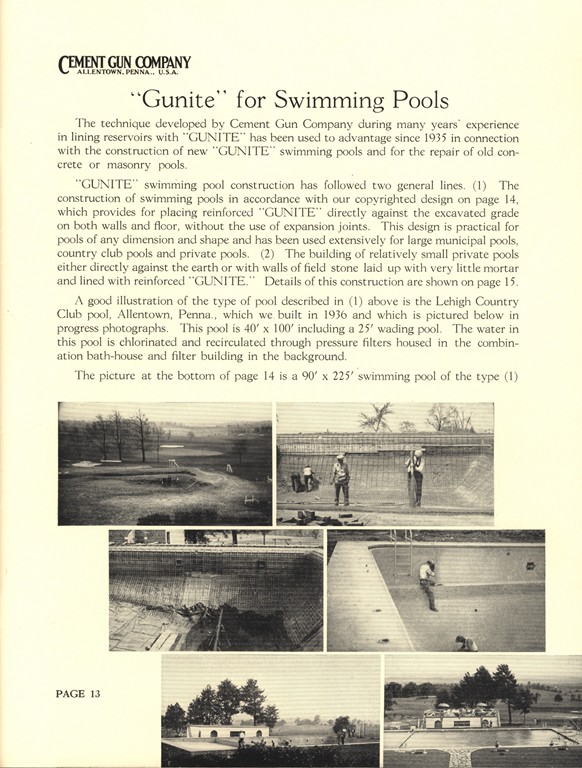 The same principles apply with concrete, and that’s true even with the small starting aggregates used with gunite and shotcrete, although filling these voids means using greater amounts of fine aggregate (sand) and more cement to ensure that there will be enough cement paste to cover the increased surface area of the smaller aggregate. The upshot of this manipulation of the mix is increased density – and, therefore, higher levels of compressive strength with gunite and shotcrete.
The same principles apply with concrete, and that’s true even with the small starting aggregates used with gunite and shotcrete, although filling these voids means using greater amounts of fine aggregate (sand) and more cement to ensure that there will be enough cement paste to cover the increased surface area of the smaller aggregate. The upshot of this manipulation of the mix is increased density – and, therefore, higher levels of compressive strength with gunite and shotcrete.
When you combine all of this, it’s easy to see why people who work with gunite and shotcrete in constructing mines and tunnels scratch their heads when they see that the pool industry has pegged its standard at 2,500 psi and are forced to wonder further if watershjapers have any clear sense of the nature of the materials and processes they’re using.
Yes, you can achieve that low, 2,500-psi level of compressive strength using cast-in-place concrete, but to do so with the gunite or shotcrete methods, you would have to torture the process with improper practices to get there – perhaps by mishandling mix times relative to temperature or repositioning the concrete once it’s been placed or using rebound (with the latter two possibilities technically meaning that the concrete is no longer “pneumatically placed”) or engaging in any of a host of other possible abuses.
The point is, if you manage to produce pneumatically placed concrete that has a compression strength of less than 4,000 psi, by definition it must be considered substandard because something had to have gone terribly wrong to produce such a result.
I believe that this has flown under the radar for so long because, compared to other applications, the preparation of shells for watershapes is not critical in construction terms. With an average pool, even 2,500 psi concrete that is coated with plaster and filled with water will be strong enough to hold that water in place and resist most ground forces. The proof of the pudding is the fact that most pools do not fail.
That said, however, if the water table changes or the plaster fails or there are soil conditions that create dramatic movement or differential settlement, it may very well prove to be the case that a substandard concrete product will be entirely inadequate. And at a time when increasing numbers of vessels have more daring shapes and performance features (including perimeter overflows and vanishing edges), the resulting structural variables make the strength of the concrete a more critical factor in the product’s ability to withstand the tests of time.
In other words, as the watershaping industry elevates the artistry and technical sophistication of its designs, the issue of proper application becomes far more important. The plain fact is, these are jobs that must be done right – first time, every time.
BACKING UP
Let’s put all of this information in a grander historical context to understand where misunderstandings about the nature of gunite and shotcrete might have emerged.
Briefly, the “cement gun” was invented in 1909 by Carl Akeley (who also, by the way, also invented the movie camera). He was working at the Chicago Museum of Natural History, patching and modeling prehistoric animals, and was frustrated by the constant need to prepare fresh batches of plaster and Portland cement, much of which went to waste before he could use it.
|
The Permeability Debate Beyond the increasing creativity of watershape designs, another issue that is pulling the watershaping industry back into the fold of the greater concrete industry is a growing set of discussion about permeability and the level to which pneumatically applied concrete – whether gunite or shotcrete – should or can be classed as permeable, slightly permeable or impermeable. We can all accept the thought that pools, spas, fountains and other bodies of recreational and decorative water should be able to contain water. What many people also accept – erroneously – is that pneumatically placed concrete is, by nature, permeable. That is so only in an environment in which substandard application practices are acceptable. In fact, the permeability of pneumatically placed concrete structures is a non-issue: When you use a proper mix design and combine it with proper application methods, the resulting 4,000 psi (or greater) material is classed as having low permeability – meaning that even without a lining in the form of plaster or an exposed-aggregate finish, the shell itself should hold water. What many contractors fail to realize is that the “business end” of the concrete is the side that comes in contact with the soil: This is the surface exposed directly to groundwater with no more than density to prevent intrusion of a sort that can corrode reinforcing steel. When the concrete is less permeable, it protects the structure’s integrity; conversely, if the shell is more permeable, it’s at far greater risk of failure. In assessing the permeability of concrete, scientists measure the passage of chloride ions that travel with water as it enters the material. Just as the compressive strength of properly applied pneumatic concrete is a well-established scientific fact, so, too, is the permeability of concrete. In this there is no dispute: 4,000 psi concrete has low permeability and, with proper concrete coverage of reinforcing steel, will protect itself from intrusion of potentially corrosive groundwater. It all adds up to a simple picture: With proper compression resulting from proper mixing and use of proper application techniques, pneumatically applied concrete is virtually free of voids, has low permeability and will withstand the tests of time. G.Y. |
An inventive sort, he noted the need for a ready flow and supply of cementitious material and developed a system in which dry cement mix was contained in a pressurized container. He attached a hose and developed a nozzle assembly that had the ability to add a measured flow of water to the mix as it exited the nozzle. Along the way, he discovered that he created a superior product by adding sand – and the rest is history.
Before too long, Akeley’s invention was commercialized by the Cement Gun Co. of Allentown, Pa., which marketed the system as Gunite. After extensive testing and product development, it was determined that the ideal velocity for the process was between 350 and 400 feet per second – a standard applied to this day and one always recognized as a critical factor in the strength and quality of the finished product.
For the next 20 years, Akeley’s system met with amazing success and rapid acceptance, and it wasn’t long before a swimming pool was constructed using the Gunite process.
That happened in 1932 at the Lehigh Valley Country Club in Allentown, which made sense because the owners of the Cement Gun Co. were club members. It was an experiment, but from the start they knew pools and pneumatically placed concrete were a perfect match – and the modern pool construction industry was born.
Fast forwarding to 1962, the country club decided to update the pool with a new plaster surface as well as some new skimmers and light niches. They hired a contractor who, after a day or two of chipping at the old concrete, went back to the club’s board of directors of the club asked for financial relief because the shell was so hard that he was going through drill bits and bull points at such a pace that he knew he’d lose money on the job.
This was no surprise to the folks at the Cement Gun Co., who had learned a lot about their product in the intervening years and had done a great deal to standardize its use. Indeed, their work rests, to this day, at the core of standards recognized and maintained by the American Concrete Institute (ACI) as well as the American Society of Testing & Materials (ASTM).
I might add that nowhere in that vast body of knowledge will you find any reference to 2,500-psi pneumatically placed concrete. In fact, studies dating to 1915 show conclusively that, when delivered at velocities of 350 to 400 feet per second, properly mixed and hydrated gunite is superior to cast-in-place concrete in bondability, density, permeability and compressive strength. Straight through the 1950s, it was generally recognized that pools built using the Gunite process were of the highest available quality and structural strength.
RAPID EXPANSION
The tide began to turn as early as 1952, when the contracting division of the Cement Gun Co. went out of business and the parent company concurred with ACI’s recommendation that it should cede its exclusive control of the Gunite process and open it to the industry. At that point, small-g gunite came on the scene.
At that time, the modern American suburb was emerging – and swimming pools were becoming an increasingly popular addition to single-family homes. With that expanding business base, numerous swimming pool contractors entered the marketplace, pioneered the concept of the middle-class swimming pool and pulled a new generation of gunite-application companies into the mix.
Without the licensing authority of the Cement Gun Co. to guide this development and train application crews as it had in the past, however, the gunite business became less disciplined and more inconsistent with respect to product quality. That gradual decline never happened in critical applications, because work on mines, highways and tunnels necessitated pursuit of very high sets of standards. Where pools were concerned, however, that same necessity did not apply and, in many quarters, a fundamental understanding of both the gunite process and product were lost.
Even so, gunite dominated in the pool industry straight through the 1960s and into the ’70s. That situation began changing by 1972, with the advent of the concrete pump and the development of the “wet” or “shotcrete” process, which really took hold in the pool market late in the 1970s.
Today, the shotcrete process is considered by many to be superior to the gunite process as a result of the consistency and reliability of batch mixes compared to the street mixing used in the gunite process. Truth is, during shotcrete’s early years, the product went through some difficult growth stages.
Mostly, these issues had to do with attempts to increase the pumpability of material: Early applicators had trouble controlling (and even holding onto) the hoses, so velocities and hose sizes both began to shrink. The result before long was that applicators weren’t so much compacting concrete as they were simply stacking it – a situation that was eventually and thoroughly rectified with improvements to shotcrete rigs and equipment but led to development of some bad habits along the way.
At the same time, market pressures led to some changes in the mix that resulted in production of weaker concrete, all in the name of minimizing costs. During the 1980s and into the ’90s, it was also common to encounter problems with concrete staying in mixers too long; with too much water being added; with the use of rebound; and, in some situations, with the addition of detergent admixtures to ease pumping. All of these factors conspired to result in terribly compromised concrete products.
This unsteadiness in the face of a changing marketplace is, I believe, what led to the odd notion that 2,500 psi strength was acceptable, even though the practices that had led to that assumption were completely substandard.
None of this, I might add, ever altered the fact that proper mix designs and application velocities were resulting in compressive strengths of 4,000 psi or better: The truth is that watershaping applications simply haven’t been classed as critical in the concrete industry and therefore attracted little technical attention – a situation that has changed in recent years with the development of more advanced and intricate designs.
THE RIGHT STUFF
As I see it, the watershaping industry can easily catch up and get back on track with the rest of the concrete-using industries with a simple process of education.
Training for concrete application, for example, already exists in the programs of the American Concrete Institute, the American Shotcrete Association and the Portland Cement Association. The specifics of proper concrete application – that is, what’s involved in rising to ACI, ASA or PCA standards – are not terribly complex, but they do require basic training.
What has happened through years in which outright product failures were rare is, in my opinion, that watershapers had latched onto the idea that common practice informally handed down through the years was sufficient in getting the job done. While that may arguably have been adequate practice at one point in time, it is increasingly less defensible: It’s time to step up and get acquainted with how things should be done rather than how they’ve been done in the past.
There are no secrets or scientific mysteries at work here: Proper use of either the gunite or shotcrete processes flows from a well-established body of knowledge based on years of experience in applications in which the success of projects is a matter of life or death, not of guesswork or old habits.
I applaud those in the watershaping industry who’ve started a critical evaluation of the way things are done and have changed their application processes to conform to the concrete industry’s standards. It’s the practical thing to do – and the right one as well.
George Yoggy has been involved in concrete application for the construction and repair of critical structures for nearly 50 years. From 1967 to 1986, he owned and operated Concrete Equipment Corp. and Shotcrete Plus, both of which were engaged in the design, manufacture and supply of equipment used in shotcreting and concrete placement in North America’s tunnel and mining industries. In 1986, the company was acquired by Master Builders, Inc., for which Yoggy established the Underground Construction Group of MBT Americas. He currently serves on various committees, including American Concrete Institute Committee 506 (Shotcrete), and is a member of the board of directors of the American Shotcrete Association and president of the American Underground Construction Association. He is also an active participant and respected leader spearheading a number of concrete industry initiatives.










